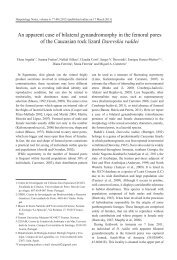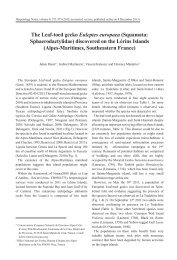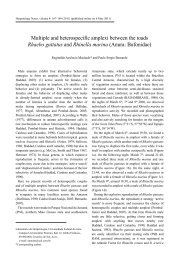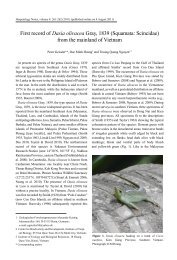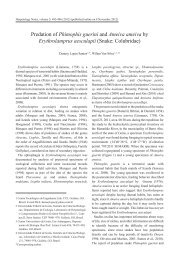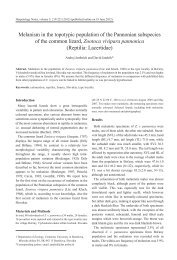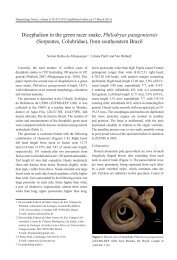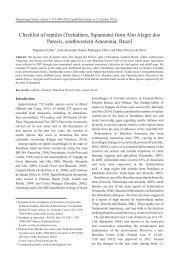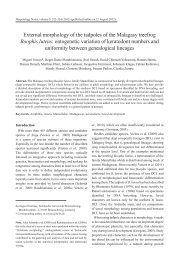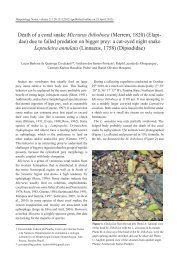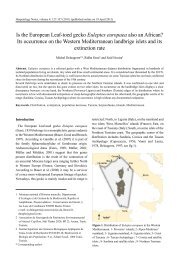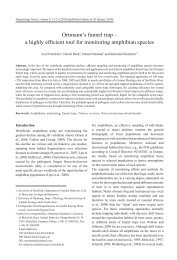Note on the intestinal bacterial populations of free living snakes in Italy
Note on the intestinal bacterial populations of free living snakes in Italy
Note on the intestinal bacterial populations of free living snakes in Italy
Create successful ePaper yourself
Turn your PDF publications into a flip-book with our unique Google optimized e-Paper software.
Herpetology <str<strong>on</strong>g>Note</str<strong>on</strong>g>s, volume 3: 263-265 (2010) (published <strong>on</strong>l<strong>in</strong>e <strong>on</strong> 30 August 2010)<br />
<str<strong>on</strong>g>Note</str<strong>on</strong>g> <strong>on</strong> <strong>the</strong> <strong><strong>in</strong>test<strong>in</strong>al</strong> <strong>bacterial</strong> populati<strong>on</strong>s <strong>of</strong> <strong>free</strong><br />
<strong>liv<strong>in</strong>g</strong> <strong>snakes</strong> <strong>in</strong> <strong>Italy</strong><br />
Ernesto Filippi 1 *, Gian Lorenzo D’Alterio 2 , Alberto Brozzi 3 , Michela Micci 3 , Pietro Politi 4 and Diego Mantero 4<br />
As part <strong>of</strong> a survey <strong>of</strong> <strong>the</strong> herpet<strong>of</strong>auna <strong>in</strong> <strong>the</strong> “Riserva<br />
Naturale Regi<strong>on</strong>ale Selva del Lam<strong>on</strong>e” protected area<br />
(Lazio Regi<strong>on</strong>, Central <strong>Italy</strong>), a bacteriological pilot<br />
study was carried out between March 23 rd and June 10 th<br />
2008. Thereby, eleven snake specimens were captured<br />
and screened for cloacal pathogens.<br />
The study area is located <strong>in</strong> Nor<strong>the</strong>rn Lazio, at <strong>the</strong><br />
border with Tuscany, and is characterized by a rich and<br />
diverse herpet<strong>of</strong>auna (Filippi et al., 2008). Distributed<br />
over a pla<strong>in</strong> area (350 m a.s.l.) <strong>the</strong> dom<strong>in</strong>ant vegetati<strong>on</strong><br />
type c<strong>on</strong>sists <strong>of</strong> Turkey oak (Quercus cerris) with o<strong>the</strong>r<br />
deciduous trees, shrubs, arable land and pasture. The<br />
study area was surveyed for <strong>snakes</strong> al<strong>on</strong>g standardised<br />
routes, cover<strong>in</strong>g various micro-habitats. Snakes were<br />
captured by hand, and several parameters were recorded:<br />
a) date, site (GPS coord<strong>in</strong>ates) and micro-habitat; b)<br />
1 Piazza Capri 20, 00141 Rome, <strong>Italy</strong>;<br />
e-mail: ernesto.filippi@fastwebnet.it<br />
2 Ambulatorio Veter<strong>in</strong>ario Farnese, Via Circ<strong>on</strong>vallazi<strong>on</strong>e snc<br />
01010 Farnese (Viterbo), <strong>Italy</strong>;<br />
e-mail: gianlorenzod@yahoo.it<br />
3 Istituto Zoopr<strong>of</strong>ilattico Sperimentale delle Regi<strong>on</strong>i Lazio e<br />
Toscana, Strada Terme 01100 Viterbo, <strong>Italy</strong>;<br />
e-mail: alberto.brozzi@izslt.it; michela_micci@yahoo.it<br />
4 Riserva Naturale Regi<strong>on</strong>ale Selva del Lam<strong>on</strong>e, Corso Vittorio<br />
Emanuele III 395 - 01010 Farnese (Viterbo), <strong>Italy</strong>;<br />
e-mail: lam<strong>on</strong>e2005@libero.it<br />
*Corresp<strong>on</strong>d<strong>in</strong>g author<br />
Table 1. Sampled snake populati<strong>on</strong> divided by species.<br />
Species<br />
Number <strong>of</strong><br />
specimens<br />
Hierophis<br />
viridiflavus<br />
Zamenis<br />
l<strong>on</strong>gissimus<br />
species; c) sex; d) snout-vent length and tail length.<br />
Out <strong>of</strong> 77 captured <strong>snakes</strong> (see Table 1) eleven<br />
specimens bel<strong>on</strong>g<strong>in</strong>g to three snake species were<br />
sampled by cloacal swab for bacteriological analysis:<br />
7 Asp Vipers (Vipera aspis), 3 Western whip <strong>snakes</strong><br />
(Hierophis viridiflavus), 1 Aesculapian snake (Zamenis<br />
l<strong>on</strong>gissimus).<br />
Briefly, swabs were <strong>in</strong>oculated <strong>on</strong>to Bra<strong>in</strong> Heart<br />
Infusi<strong>on</strong> broth and <strong>in</strong>cubated at 30 +/- 1 C° and 37 +/- 1<br />
C° for 24 hours. Broths were <strong>the</strong>n transferred <strong>on</strong>to blood<br />
and agar <strong>in</strong>cubated as above. Col<strong>on</strong>ies were identified<br />
by Gram’s sta<strong>in</strong><strong>in</strong>g oxidase test, by <strong>in</strong>oculati<strong>on</strong> <strong>on</strong>to<br />
Triple Sugar Ir<strong>on</strong> and by API 20E system (Bio-<br />
Meurieux). Col<strong>on</strong>ies identified as Salm<strong>on</strong>ella spp. were<br />
<strong>the</strong>n typified by <strong>the</strong> autoagglut<strong>in</strong>ati<strong>on</strong> sal<strong>in</strong>e test, <strong>the</strong><br />
polyvalent agglut<strong>in</strong>ati<strong>on</strong> antisera test (A-O67) and by<br />
serological test<strong>in</strong>g follow<strong>in</strong>g <strong>the</strong> Kauffmann and White<br />
scheme (Carter and Cole, 1990; Holt et al., 1994; OIE,<br />
2008).<br />
The results <strong>of</strong> <strong>the</strong> bacteriological exam<strong>in</strong>ati<strong>on</strong> <strong>of</strong> <strong>the</strong><br />
cloacal swabs and o<strong>the</strong>r data are reported <strong>in</strong> Table 2.<br />
All sampled <strong>snakes</strong> tested positive for a mixed Gramnegative<br />
<strong>bacterial</strong> flora. However, three V. aspis and<br />
<strong>on</strong>e Hierophis viridiflavus yielded positive results for<br />
Salm<strong>on</strong>ella enterica diariz<strong>on</strong>ae IIIb.<br />
Many reptiles harbor a mixed Gram-negative <strong>bacterial</strong><br />
flora <strong>in</strong> <strong>the</strong>ir cloaca, and this presence is difficult<br />
to <strong>in</strong>terpret. Bacteria, such as Pseudom<strong>on</strong>as spp.,<br />
Klebsiella spp., Serratia spp. and Providencia spp.,<br />
all <strong>of</strong> which have been isolated <strong>in</strong> this study, are all<br />
Elaphe<br />
quatuorl<strong>in</strong>eata<br />
Natrix<br />
natrix<br />
Natrix<br />
tessellata<br />
Vipera<br />
aspis<br />
40 6 2 4 2 23
264<br />
c<strong>on</strong>sidered opportunistic pathogens <strong>in</strong> reptiles, and <strong>the</strong>ir<br />
presence <strong>in</strong> associati<strong>on</strong> with overt cl<strong>in</strong>ical signs should<br />
be c<strong>on</strong>sidered as significant (Rosenthal and Mader,<br />
1996).<br />
Salm<strong>on</strong>ella enterica has been previously isolated from<br />
<strong>free</strong>-<strong>liv<strong>in</strong>g</strong> <strong>snakes</strong> (Malmqvist et al., 1995; Geue and<br />
Löschner, 2002; Bri<strong>on</strong>es et al., 2004; Köbölkuti et al.,<br />
2009), ), captive <strong>snakes</strong> (Kennedy, 1973; Chiod<strong>in</strong>i and<br />
Sundberg, 1981; Geue and Löschner, 2002; Schroter et<br />
al., 2004) and <strong>the</strong>ir envir<strong>on</strong>ment <strong>in</strong> captivity (Bauwens<br />
et al., 2006), <strong>in</strong>clud<strong>in</strong>g pet <strong>snakes</strong> <strong>in</strong> <strong>Italy</strong> (Ebani et al.,<br />
2005).<br />
Ernesto Filippi et al.<br />
Table 2. Date, species, sex and size (Svl: snout-vent length (cm); Tl: tail length (cm)) and results <strong>of</strong> bacteriological analysis <strong>of</strong><br />
cloacal swab<br />
Date Species Sex Svl Tl Isolates<br />
23 March V. aspis M 50 62<br />
30 April H. viridiflavus F 90 122<br />
30 April H. viridiflavus F 71 99<br />
30 April V. aspis F 40 46<br />
30 April V. aspis M 54 63<br />
07 May V. aspis M 43 47.5<br />
Hafnia alvei; Salm<strong>on</strong>ella enterica sub.<br />
diariz<strong>on</strong>ae<br />
Serratia liquefaciens; Citrobacter spp.;<br />
Morganella morganii; Buttiaux agrestis<br />
Serratia liquefaciens; Citrobacter spp.;<br />
Morganella morganii; Buttiaux agrestis;<br />
Lactococcus lactis<br />
Serratia liquefaciens; Citrobacter spp.;<br />
Morganella morganii; Buttiaux agrestis<br />
Pseudom<strong>on</strong>as fluorescens; Serratia<br />
liquefaciens; Citrobacter spp.; Morganella<br />
morganii; Buttiaux agrestis<br />
Klebsiella pneum<strong>on</strong>iae; Serratia<br />
liquefaciens; Citrobacter spp.<br />
07 May V. aspis F 57 -- Serratia liquefaciens; Citrobacter spp.<br />
07 May Z. l<strong>on</strong>gissimus M 94 117 Serratia liquefaciens; Citrobacter spp.<br />
10 June V. aspis F 46 51.5<br />
10 June V. aspis M 49 56<br />
10 June H. viridiflavus F 84 111<br />
Escherichia coli; Corynebacterium sp.;<br />
Providencia rettgeri; Salm<strong>on</strong>ella enterica<br />
sub. diariz<strong>on</strong>ae<br />
Salm<strong>on</strong>ella enterica sub. diariz<strong>on</strong>ae;<br />
Providencia rettgeri;<br />
Salm<strong>on</strong>ella enterica sub. diarizoane;<br />
Providencia rettgeri; Corynebacterium spp.;<br />
Pasteurella pneumotropica<br />
However, to <strong>the</strong> best <strong>of</strong> <strong>the</strong> authors’ knowledge <strong>the</strong>se<br />
are <strong>the</strong> first reported Salm<strong>on</strong>ella isolates from wild<br />
specimens <strong>of</strong> Vipera aspis and Hierophis viridiflavus.<br />
Salm<strong>on</strong>ella species are potential pathogens for reptiles<br />
<strong>in</strong> general (Funk, 1996), and Salm<strong>on</strong>ella enterica<br />
diariz<strong>on</strong>ae is a rarely reported zo<strong>on</strong>otic agent (Bru<strong>in</strong>s<br />
et al., 2006).<br />
The present study, which was carried out by<br />
c<strong>on</strong>servati<strong>on</strong> biologists and veter<strong>in</strong>ary health<br />
pr<strong>of</strong>essi<strong>on</strong>als, highlighted a potential biological threat<br />
to <strong>the</strong> <strong>snakes</strong> under survey. Additi<strong>on</strong>ally, <strong>the</strong> role <strong>of</strong><br />
wild <strong>snakes</strong> as a reservoir <strong>of</strong> Salm<strong>on</strong>ella species was
Intest<strong>in</strong>al <strong>bacterial</strong> populati<strong>on</strong>s <strong>of</strong> <strong>free</strong> <strong>liv<strong>in</strong>g</strong> <strong>snakes</strong> 265<br />
c<strong>on</strong>firmed, hence <strong>the</strong> need to apply strict hygienic<br />
precauti<strong>on</strong>s when handl<strong>in</strong>g <strong>the</strong>m.<br />
C<strong>on</strong>sider<strong>in</strong>g <strong>the</strong> decl<strong>in</strong>e <strong>of</strong> many snake populati<strong>on</strong>s<br />
(Read<strong>in</strong>g et al., 2010) and that <strong>the</strong> spread<strong>in</strong>g <strong>of</strong><br />
diseases is c<strong>on</strong>sidered to be <strong>on</strong>e <strong>of</strong> <strong>the</strong> causes for <strong>the</strong><br />
decl<strong>in</strong>e <strong>in</strong> reptiles <strong>in</strong> general (Gibb<strong>on</strong>s et al., 2000), it is<br />
important to remember that “today’s commensal may be<br />
tomorrow’s pathogen” (Cooper, 2000).<br />
Acknowledgements. We thank <strong>the</strong> whole staff <strong>of</strong> Riserva<br />
Naturale Regi<strong>on</strong>ale Selva del Lam<strong>on</strong>e for <strong>the</strong>ir assistance <strong>in</strong> <strong>the</strong><br />
field. M. Capula critically reviewed an earlier versi<strong>on</strong> <strong>of</strong> this<br />
paper. The work <strong>of</strong> <strong>on</strong>e <strong>of</strong> <strong>the</strong> authors (EF) was supported by<br />
Riserva Naturale Regi<strong>on</strong>ale Selva del Lam<strong>on</strong>e- Regi<strong>on</strong>e Lazio<br />
(projects No 295-384/2007). No animals were damaged or killed<br />
dur<strong>in</strong>g <strong>the</strong> present project, and all were handled accord<strong>in</strong>g to <strong>the</strong><br />
<strong>in</strong>ternati<strong>on</strong>al scientific standards.<br />
References<br />
Bauwens, L., Vercammen, F., Bertrand, S., Collard, J.M., De<br />
Ceuster, S. (2006): Isolati<strong>on</strong> <strong>of</strong> Salm<strong>on</strong>ella from envir<strong>on</strong>mental<br />
samples collected <strong>in</strong> <strong>the</strong> reptile department <strong>of</strong> Antwerp<br />
zoo us<strong>in</strong>g different selective methods. J. Appl. Microbiol.<br />
101: 284-9.<br />
Bri<strong>on</strong>es, V., Téllez, S., Goyache, J., Ballesteros, C., Pilar Lanzarot,<br />
M., Domínguez, L., Fernández-Garayzábal, J. F. (2004):<br />
Salm<strong>on</strong>ella diversity associated with wild reptiles and amphibians<br />
<strong>in</strong> Spa<strong>in</strong>. Envir. Microbiol. 6: 868-871.<br />
Bru<strong>in</strong>s, M.J., de Boer, A.M., Ruijs, G.J. (2006): Gastroenteritis<br />
caused by Salm<strong>on</strong>ella from pet <strong>snakes</strong>. Ned. Tij. Gen. 150:<br />
2266-9.<br />
Carter, G. R., Cole G. R (Eds) (1990): Diagnostic Procedures <strong>in</strong><br />
Veter<strong>in</strong>ary Bacteriology and Mycology. San Diego, California,<br />
Academic Press Inc.<br />
Chiod<strong>in</strong>i, R.J., Sundberg, J.P., 1981. Salm<strong>on</strong>ellosis <strong>in</strong> reptiles: a<br />
review. Am. J. Epidemiol. 113: 494–499.<br />
Cooper, J.E. (2000): Reptilian microbiology. In: Laboratory Medic<strong>in</strong>e:<br />
avian and exoticpets, p. 223-228. Fudge, A.M., Ed.,<br />
Philadelphia, W.B. Saunders Company.<br />
Ebani, V.V., Cerri, D., Frat<strong>in</strong>i, F., Meilli, N., Valent<strong>in</strong>i, P., Andreani,<br />
E. (2005): Salm<strong>on</strong>ella enterica isolates from faeces <strong>of</strong><br />
domestic reptiles and a study <strong>of</strong> <strong>the</strong>ir antimicrobial <strong>in</strong> vitro<br />
sensitivity. Res. Vet. Sci. 78: 117-21.<br />
Filippi, E, Baragliu, G.A., Biselli, F., Ceccar<strong>in</strong>i, A., Ciavatta, D.,<br />
De Parri, I., Fapperdue,G., Mantero, D., Marchi<strong>on</strong>ni, F., Politi,<br />
P., Sschiavano, A., Terazzi, A. (2008): Check-list <strong>of</strong> <strong>the</strong><br />
herpet<strong>of</strong>auna <strong>in</strong>habit<strong>in</strong>g <strong>the</strong> Riserva Naturale Regi<strong>on</strong>ale Selva<br />
del Lam<strong>on</strong>e (Viterbo-Latium): new important records <strong>in</strong> central<br />
<strong>Italy</strong>. In:Herp. Sard., p. 270-273. Corti, C., Ed., Lat<strong>in</strong>a, Ed.<br />
Belvedere.<br />
Funk, R.S. (1996): Diarrhea. In: Reptile Medic<strong>in</strong>e and Surgery,<br />
p. 322-325. Mader, D.R., Ed., Philadelphia, W.B. Saunders<br />
Company.<br />
Geue, L., Löschner, U. (2002): Salm<strong>on</strong>ella enterica <strong>in</strong> reptiles<br />
<strong>of</strong> German and Austrian orig<strong>in</strong>. Veter<strong>in</strong>ary Microbiology. 84:<br />
79-91.<br />
Gibb<strong>on</strong>s JW, Scott, D.E, Ryan, T.J., Buhlmann, K.A., Tuberville,<br />
T.D., Metts, B.S., Greene, J.L., Mills, T., Leiden, Y., Poppy,<br />
S., W<strong>in</strong>ne, C.T. (2000): The global decl<strong>in</strong>e <strong>of</strong> reptiles, déjà vu<br />
amphibians. BioScience 50: 653-666.<br />
Holt J. G., Krieg N. R., Sneath P. H. A., Staley J. T., Williams S.<br />
T. (Eds). Bergey’s Manual <strong>of</strong> Determ<strong>in</strong>ative Bacteriology, 9th<br />
Editi<strong>on</strong>, Baltimore, USA Williams & Wilk<strong>in</strong>s.<br />
Kennedy, M.E. (1973): Salm<strong>on</strong>ella isolati<strong>on</strong>s from <strong>snakes</strong> and<br />
o<strong>the</strong>r reptiles. Can. J. comp. Med. 37: 325-326.<br />
Köbölkuti, L., Sp<strong>in</strong>u, M., Cadar, G., Czirjak,G., Kiss, T. (2009):<br />
Classical and molecular m<strong>on</strong>itor<strong>in</strong>g <strong>of</strong> <strong>the</strong> prevalence <strong>of</strong> Salm<strong>on</strong>ella<br />
spp. carriage <strong>in</strong> <strong>free</strong><strong>liv<strong>in</strong>g</strong> and captive native <strong>snakes</strong> <strong>in</strong><br />
Romania. Lucrari Sti<strong>in</strong>ifice Med. Vet. XLII: 294-297.<br />
Malmqvist, M., Jacobss<strong>on</strong>, K.G., Häggblom, P., Cerenius, F.,<br />
Sjöland, öland, L., Gunnarss<strong>on</strong>, A. (1995): Salm<strong>on</strong>ella isolated from<br />
animals and feedstuffs <strong>in</strong> Sweden dur<strong>in</strong>g 1988-1992. Acta Vet.<br />
Scand. 36: 21-39.<br />
OIE (2008): Manual <strong>of</strong> Diagnostic Tests and Vacc<strong>in</strong>es for Terrestrial<br />
Animals, 6th Editi<strong>on</strong>, Paris, OIE - World Organisati<strong>on</strong><br />
for Animal Health.<br />
Read<strong>in</strong>g, C. J., Luiselli, L.M., Akani, G.C., B<strong>on</strong>net, X, Amori, G.,<br />
Ballouard, J.M., Filippi, E., Naulleau, G., Pears<strong>on</strong>, D., Rugiero,<br />
L. (2010): Are snake populati<strong>on</strong>s <strong>in</strong> widespread decl<strong>in</strong>e?<br />
Biology Letters: <strong>in</strong> press.<br />
Rosenthal, K.L., Mader, D.R. (1996): Microbiology. In: Reptile<br />
Medic<strong>in</strong>e and Surgery, p. 117-125. Mader, D.R., Ed., Philadelphia,<br />
W.B. Saunders Company.<br />
Schröter, M., Roggent<strong>in</strong>, P., H<strong>of</strong>mann, J., Speicher, A., Laufs, R.,<br />
Mack, D. (2004): Pet Snakes as a Reservoir for Salm<strong>on</strong>ella enterica<br />
subsp. diariz<strong>on</strong>ae (Serogroup IIIb): a Prospective Study.<br />
Appl. Envir<strong>on</strong>. Microbiol. 70: 613–615.<br />
Accepted by Zoltn Zoltn . . . agy<br />
agy agy



